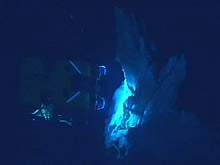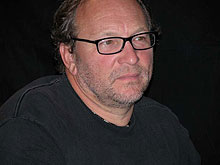
Dr. Jeff Karson, Geologist. Image courtesy of NOAA.
IFE ROV Hercules shines bright lights on towers and chimneys providing new images of this unique hydrothermal vent field. Click image for larger view and image credit.
Growth at Lost City
July 25, 2005
Dr. Jeff Karson
Geologist
Ethereal white towers emerge from over 2,000 feet below the surface (Quicktime, 884 Kb)
Today we returned to the Lost City. We fortuitously discovered the field in 2000 while we were investigating the formation of the Atlantis Massif, the mountain that the Lost City is perched upon. During that program, we got an initial glimpse of the field using the Argo II ROV and a single Alvin dive. Three years later we were back with a major program of 19 Alvin dives and the Autonomous Benthic Explorer (ABE). These tools allowed us to make a very detailed bathymetric map revealing the shape of the field and to make a major collection of rocks, vent structures, fluids, gasses and fauna. After this program and our follow-up studies, we felt that we knew the area quite well before we arrived. From our earlier studies, we had the general impression that the Lost City, despite its size (a couple hundred meters across) and complexity, had grown rather slowly. Radiometric dates indicated that the field was about 30,000 years old and the flow rates observed at even the most vigorous vents were rather sluggish compared to that of magmatically-driven black smoker vents. So, it was surprising to see evidence of significant changes in the field over the last 2 years.
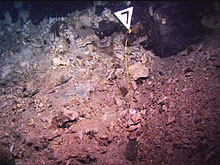
Marker 7 fell from the Nature Tower sometime between the 2003 Lost City expedition and this one. After finding the fallen marker, Hercules picked it up and replaced it on the Nature Tower. Click image for larger view and image credit.
In 2003 we left floating markers on top of spires and pinnacles to mark the places we had taken samples. It was a good thing we did. Some of the structures had obviously grown by the precipitation of masses of new material and were hard to recognize. Some areas featured new, brilliant white carbonate flanges (shelf-like horizontal growths) up to a couple feet across. In one case, a part of a complex spire had fallen off, taking with it the marker we had left. We were lucky to find the marker in a heap of rubble at the base of that tower- at least 30 meters below where we had left it! These sorts of modifications were found at nearly every site that was active during our 2003 program.
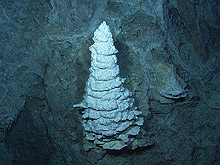
This beautiful, actively venting carbonate structure resembling a snow-covered Christmas tree is about 3 feet high. "The beehive" is perched precariously on the near-vertical side of the 200-ft-tall Poseidon tower. Older light gray carbonate cut by white carbonate veins in the background are on the side of Poseidon. Click image for larger view and image credit.
The most dramatic change was evident at a distinctive hydrothermal structure we call "the beehive." It is a cone-like structure that resembles a small (about 3 feet high) snow-covered Christmas tree. We sampled fluids and fauna very extensively at this site in 2003 and on our last visit to this feature it was inadvertently bumped. It fell from the steep side of one of the major spires in the field and ended up in pieces on the seafloor. This provided a valuable growth experiment for us. We were startled and also pleased today to see that the structure had grown back in an almost identical form. This re-growth gives us a terrific constraint on the possible growth rates of the structures in the Lost City field. Because this structure formed (both times!) in one of the areas of highest flow rate, it probably represents something near the high end of growth rates for structures in the field.
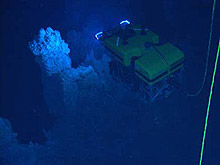
IFE ROV Hercules lights up the huge white chimneys of Lost City hydrothermal vent field. The cable in the foreground connects the ROV Hercules to the ROV Argus. The towers made of calcium carbonate shine brightly in the light. Click image for larger view and image credit.
We spent most of the day and into the night making a grand tour of the Lost City area. We traveled all the way around the main part of the field, stopping frequently to acquire high-quality digital video and still images of key features and also to collect some samples of vent material, fluids, and a few animals. Although many of us here at the University of Washington science command center had been involved in previous studies of the Lost City and even made Alvin dives in the field, the view we got from Argus/Hercules was mesmerizing. None of us had seen the entire field before. The high-definition cameras on Hercules gave us incredibly sharp and brilliant images of the full range of structures in the area. My favorite views, however, came from IFE ROV Argus. The Argus vehicle hovers about 100 feet above the IFE Hercules ROV and helps manage its fiber optic umbilical cord. Argus also is equipped with cameras and powerful lights. The views of the seafloor with Hercules far below, all lit in a ghostly light was otherworldly. The combined lights of Argus and Hercules illuminated broad areas of seafloor and massive sections of hydrothermal spires that we could hardly have imagined from our previous, myopic wanderings though the field. It was as if the sun had come out to suddenly reveal a seascape where we had previously been wandering around in the dark with a flashlight. I am sure that I was not the only one who was thinking about other places on the seafloor where we had worked before and wondering what they might look like from the perspective of Argus and Hercules.
Sign up for the Ocean Explorer E-mail Update List.



























